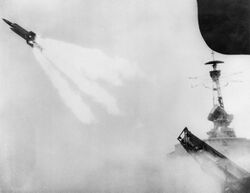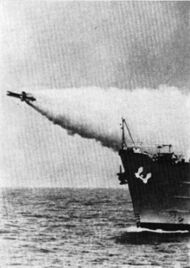Engineering:HMS Girdle Ness (A387)
HMS Girdle Ness was a Royal Navy ship, used to support missile trials in the development of the Seaslug missile.
Construction
HMS Girdle Ness was built towards the end of WWII as HMS Penlee Point (F04). She was built by the Burrard Dry Dock Co. Ltd. in Vancouver, Canada, as one of twenty one Beachy Head-class repair ships. These were Canadian 'Fort' ships, similar to the US 'Victory' ships, both a more powerful and faster version of the Liberty ship but still using a single shaft and triple-expansion steam engine.
Penlee Point was laid down on 7 December 1944, launched on 29 March 1945 and commissioned on 5 September 1945.[1][2]
On entering service she was used as an accommodation ship at Rosyth Dockyard from 1946 to 1952, being placed in reserve in 1951.[3]
Conversion as a trials ship
A trials ship was needed to support the Seaslug missile development program. Initial tests were carried out from a shore-based launcher but there was a need to test the missile under realistic conditions, and also to gain experience of handling a large missile at sea.
In February 1953 Penlee Point was moved to Devonport Dockyard, Devon, for conversion into a trials ship. The conversion began in May 1953 and was completed in 1956, and she was re-commissioned as Girdle Ness on 24 July.
During her conversion the entire superstructure was removed and most of the forward part of the hull gutted to provide space for the missile launcher and its attendant magazines. When she was finally completed in her new guise she had a large, boxy bridge structure forward of which was a triple Seaslug launcher.
One of the reasons why Girdle Ness was chosen for conversion was a result of a 1950 Admiralty Ship Design Policy Committee recommendation. The committee proposed that three missile-equipped types of ship would be required by the Royal Navy:
- A: Task Force Ship, capable of 30 knots, and armed with two triple Seaslug launchers
- B: Ocean Convoy Escort, capable of 17 knots, and armed with two triple Seaslug launchers
- C: Coastal Convoy Escort, capable of 12 knots, and armed with a triple Seaslug launchers
Girdle Ness was chosen to be a prototype for the Type C: Coastal Convoy Escort, although this idea was dropped before she came into service.
Radar equipment
Seaslug's guidance was a beam riding system, with the missile following a beam projected from the launching ship. This required the installation of a large radar set, for both target acquisition, tracking and the control beam.
The following equipment was installed:[4][page needed]
- Parabolic telemetry antenna
- Type 901 radar[5]
- Type 960 radar[6]
- Type 983 height-finding radar[7]
- Type 982 radar[8]
Missile trials
Seaslug was first tested at RAE Aberporth, on the Welsh coast of Cardigan Bay. Aberporth already hosted the land-based launcher, the Clausen Rolling Platform or HMS Rock'n'Roll.[9][10] Later trials were carried out in the Mediterranean, based on Malta.
Seaslug was the UK's first ship-based surface-to-air missile. It used four solid boosters, then a solid sustainer rocket. Once the boosters were dropped and the sustainer fired, four large control surfaces were used to control the missile under beam-riding guidance.[11] Seaslug was a large missile and required mechanical handling to transfer the rounds from the magazine to the trainable launcher. The large magazine was relatively highly automated for its age.[3][12]
During trials, the ship was crewed by a naval crew, with the missile operators being the first naval staff under training as missile operators. The Recording Room manned by civilian members of the RN Scientific Service analysing the performance of the Seaslug.[13]
In 1959 RFA Retainer was used for trials of replenishment at sea, transferring the two ton complete missile rounds by highline breeches buoy.[14]
Withdrawal
During the course of her life as a missile trials ship Girdle Ness fired 209 Seaslug missiles.
When the trials ended, she returned to Devonport and was paid off on 5 December 1961.[16][17] She was then reclassified as an accommodation ship, and after her return to Rosyth she was re-commissioned on 1 December 1962 and served alongside HMS Duncansby Head, another Beachy Head-class ship, at Donibristle. HMS Girdle Ness was decommissioned in early 1970 and was scrapped in Faslane from August 1970 onwards.
The ship's badge, a golden girdle as a trefoil knot on a blue field, is now held by the National Maritime Museum, Greenwich.[18]
See also
- Girdle Ness
- Girdle Ness Lighthouse, by Robert Stevenson
- Tracking ship
- USS Mississippi (AG-128) ex (BB-41), development ship in a similar role for the US Navy's RIM-2 Terrier missile.
External Links
References
- ↑ http://uboat.net/allies/warships/ship/7311.html
- ↑ "HMS Girdle Ness (sic): HMS Penlee Point, as built as a landing craft repair ship". McCord Museum. http://collections.musee-mccord.qc.ca/en/collection/artifacts/27-2291?Lang=1&accessnumber=27-2291.
- ↑ 3.0 3.1 Wise, Jon (2007). Jordan, John. ed. Warship 2007. Conway. pp. 9–28. ISBN 978-1844860418.
- ↑ Wise (2007).
- ↑ "Type 901 radar". http://www.rnmuseumradarandcommunications2006.org.uk/901_P.html.
- ↑ "Type 960 radar". http://www.rnmuseumradarandcommunications2006.org.uk/960.pdf.
- ↑ "Type 983 radar". http://www.rnmuseumradarandcommunications2006.org.uk/983.pdf.
- ↑ "Type 982 radar". http://www.rnmuseumradarandcommunications2006.org.uk/982.pdf.
- ↑ "A Brief History of RAE Aberporth". http://www.rafaberporth.org.uk/page6.html.
- ↑ "The Duke Sees Two Sea Slugs Fired". 6 December 1959. http://www.ceredigion.gov.uk/utilities/action/act_download.cfm?mediaid=17724.
- ↑ "Seaslug: The Most Missile In The Least Space". Flight: 790–794. 21 November 1958. https://www.flightglobal.com/pdfarchive/view/1958/1958-1-%20-%200786.html.
- ↑ "The missile loading control position in HMS GIRDLE NESS, November 1958.". Imperial War Museum. http://www.iwmprints.org.uk/image/727209/the-missile-loading-control-position-in-hms-girdle-ness-november-1958.
- ↑ "HMS Girdle Ness. November 1958, on Board the Navy's Guided Weapons Trials Ship. Control Rooms and Loading Spaces of HMS Girdle Ness.". Admiralty. http://www.iwm.org.uk/collections/item/object/205164313.
- ↑ "Seaslug transfer". 1959. http://www.rfanostalgia.org/gallery3/index.php/REPLENISHMENT-AT-SEA/RFAs/Retainer-Girdle-Ness.
- ↑ "HMS Girdleness Fires The Seaslug Missile 1961". British Pathé News. 4 December 1961. http://www.britishpathe.com/video/hms-girdleness-fires-the-seaslug-missile.
- ↑ "HMS Girdleness Returns From Seaslug Missile Trials". British Pathé News. 5 December 1961. http://www.britishpathe.com/video/hms-girdleness-returns-from-seaslug-missile-trials/query/Girdleness.
- ↑ "Seaslug Trials Completed". Flight: 904. 14 December 1961. https://www.flightglobal.com/pdfarchive/view/1961/1961%20-%201792.html.
- ↑ "Official ship's badge of HMS Girdle Ness". http://collections.rmg.co.uk/collections/objects/1728.html.
- http://wargamingmiscellany.blogspot.co.uk/2016/04/hms-girdle-ness.html
- "Devonport Navy Day". http://www.axfordsabode.org.uk/pdf-docs/navday06.pdf.
- Jon Berry (November 2011). "Desperately seeking Sea Slug". Context (122). http://ihbconline.co.uk/context/122/#21/z.
- Wise, Jon (2007). John Jordan. ed. RFA Girdle Ness: Sea Slug Missile Trials Ship. Warship 2007. London: Conway. pp. 9–28. ISBN 1-84486-041-8.
- http://www.rnmuseumradarandcommunications2006.org.uk/SEASLUG_DOCUMENTATION_P1.html
- "With the Royal Navy". All Hands: 18. 1962. http://www.navy.mil/ah_online/archpdf/ah196202.pdf.



